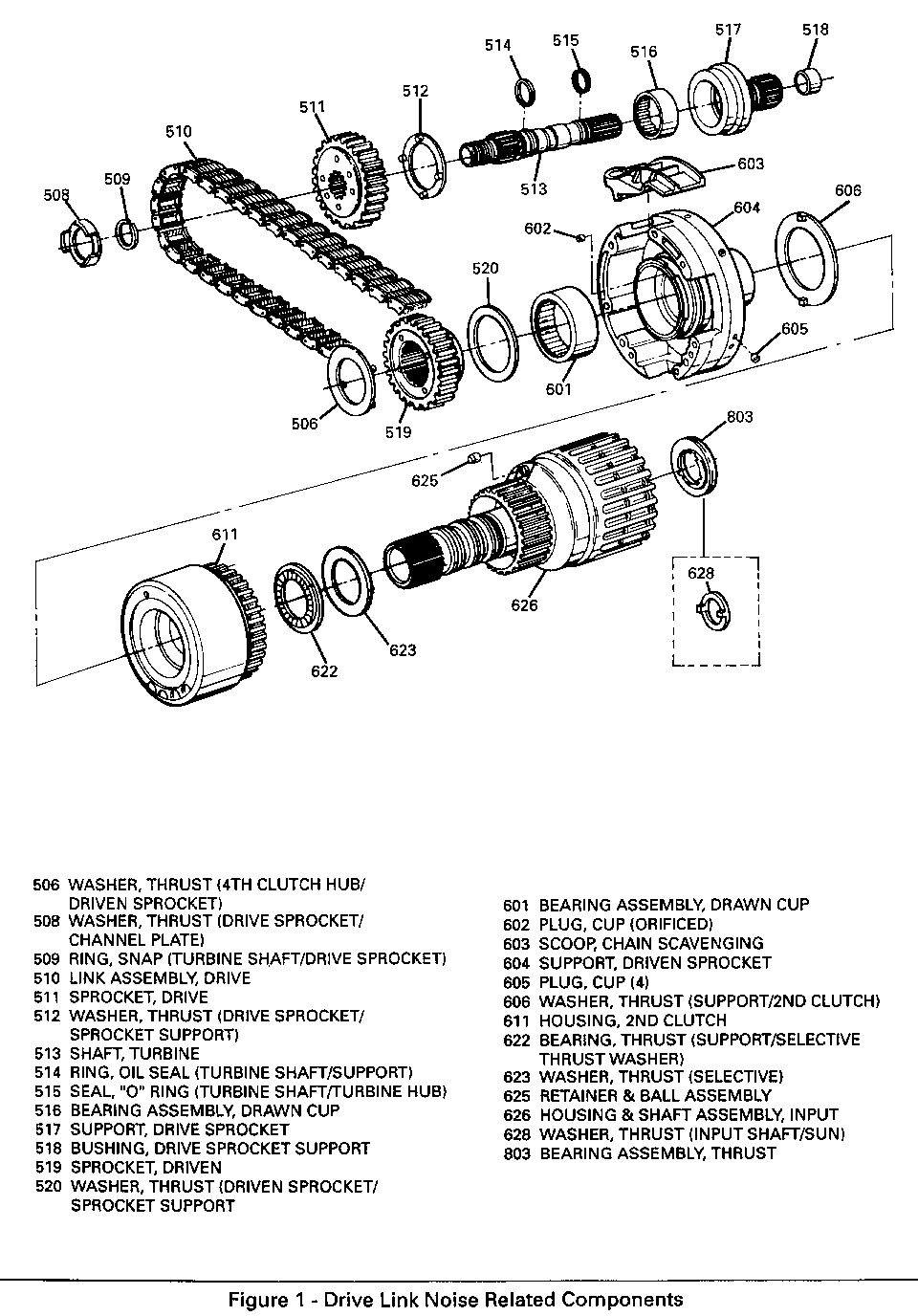DRIVE LINK NOISE-IN PARK/ NEUTRAL

SUBJECT: DRIVE LINK NOISE-IN PARK/NEUTRAL, DIAGNOSIS
MODELS/YEARS: ALL 1984-1991 MODELS EQUIPPED WITH HYDRA-MATIC 4T60 OR 4T60-E
This bulletin covers drive link diagnosis tips - all 1984-91 HYDRA-MATIC 4T60 and 4T60-E transaxles (see the illustration). Damaged drive link components may exhibit one of the following conditions:
1. A whine/whistle (that could sound like generator whine) or growling noise in Park and Neutral and stops when the vehicle is put in Drive or Reverse (with the vehicle not moving). When the vehicle is driven, this whine or growling noise (the noise may not be noticeable when the vehicle is driven) increases and fades with vehicle speed and is most noticeable under light throttle acceleration. This whine/whistle noise is usually caused by a damaged drive sprocket support bearing (*516, for 4T60; **521 for 4T60-E). Replace the bearing if necessary.
* The illustration shows HYDRA-MATIC 4T60 drive link components.
** HYDRA-MATIC 4T60-E item numbers not shown. Reference 4T60-E components.
2. Noise under hard acceleration (drive link jumping sprocket teeth, rubbing on transaxle case or the driven sprocket support because of drive link stretch).
IMPORTANT: (Other vehicle related noises) Final drive hum, most noticeable under light throttle acceleration. Gear noise (whine) most noticeable in first gear and reverse. Gear noise diminishes or becomes less noticeable after an upshift. Pump noise (high pitch whine) increases in intensity with increase in engine RPM. Pump noise is also noticeable in Park and Neutral operating ranges with the vehicle stationary.
When diagnosing a transaxle for one of the above conditions, the following items should be checked first:
1. Test drive the vehicle to verify the condition. Also, verify that the noise is not transaxle final drive, gear, pump, engine or engine accessories noise. It would be helpful to use a stethoscope or a long rubber heater hose to help pinpoint the exact source of the noise.
2. Remove the converter cover and remove the converter to flywheel (flex plate) bolts. Then pull away the converter from the flywheel without bending the flywheel (these bolts have to be removed anyway to remove the transaxle).
o Start the engine,
- If the noise goes away, then go to step 3.
- If the noise still occurs, then take off the accessories belt(s). Start the engine again; if the noise still occurs, then it is an engine related noise such as the engine oil pump, or other rotating internal engine components such as the balance shaft bearings, etc. If the noise stops, then the belt(s) or one of the accessories should be repaired. Refer to the Service Manual for details.
3. Remove the transaxle and remove the channel plate. Check the following components:
Rotate the drive link assembly a couple of complete revolutions - does the drive link get tight on the sprockets in one or two areas? If it does, inspect all the teeth of the drive sprocket. They all must be identical - if a couple of teeth are different or damaged, replace the suspected sprocket. If the drive link assembly rotates easily without drag or resistance, check the following components:
- Drive link assembly for broken link(s) in any of the many rows in the assembly.
- Drive link wear - refer to page 62 of the April 1990 issue of Service Guild for details. Replace the drive link if necessary.
- Drive and driven sprocket teeth. All the teeth of each sprocket must be identical - if a couple of teeth are different or damaged, replace the suspected part(s). Also, check the areas where the sprockets ride against bearings or thrust washers for spalling or pitting - replace the sprocket(s) if necessary.
- Drive and driven sprocket support roller bearing(s) for spalling or pitting - replace the bearing(s) if damaged or missing needle(s).
- Plastic thrust washers damaged or missing - replace if necessary.
- 4th clutch shaft bearing assembly (504) that is missing or damaged. Remember, one needle is supposed to be missing to allow lubrication to the 4th clutch assembly.
- If all the components check out OK, then replace the drive sprocket support bearing (*516, for 4T60 and **521 for 4T60-E).

General Motors bulletins are intended for use by professional technicians, not a "do-it-yourselfer". They are written to inform those technicians of conditions that may occur on some vehicles, or to provide information that could assist in the proper service of a vehicle. Properly trained technicians have the equipment, tools, safety instructions and know-how to do a job properly and safely. If a condition is described, do not assume that the bulletin applies to your vehicle, or that your vehicle will have that condition. See a General Motors dealer servicing your brand of General Motors vehicle for information on whether your vehicle may benefit from the information.
